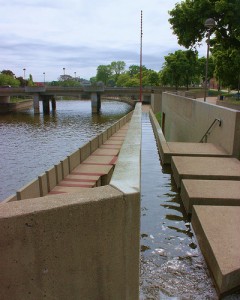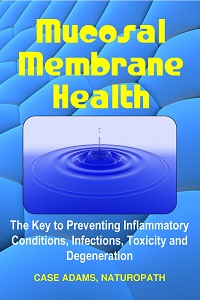How Flint Water Crisis Could Happen Anywhere

Flint River. Source of lLead watercrisis in Flint.
The Flint, Michigan water crisis is not an isolated event. It is not as if the water system in Flint is that unlike the water systems in many cities throughout the U.S., and throughout the world for that matter.
The reality is that any of us living within a city that has had their water system built at least a couple of decades ago could be subject to a crisis like Flint. This doesn’t count the many buildings and houses that have lead pipes. The Baltimore and Washington crises also attest to this fact.
Let’s quickly review the circumstances of the Flint water crisis for those who may not be totally aware of what happened.
It started back in 2013, when a city manager appointed by the governor’s office in Michigan wanted to save the town of Flint some money. They developed a project to pull their water supplies directly out of Lake Heron. At the time, and the near past, Flint was buying water from Detroit, which pulled it out of the lake.
Flint’s budget couldn’t handle the cost of buying water from Detroit. So it set out to build a pipeline to the lake.
The problem was, the pipeline wasn’t going to be completed until 2016, and the Detroit water department decided to cut off Flint’s access to their water.
In a pinch, the city began drawing water out of the Flint River to deliver to its residents. The problem is that the Flint River is so polluted, that it was high in corrosives – particularly chloride. The corrosive nature of chloride has the effect of leaching lead out of the water pipes.
For this reason, most municipalities utilize phosphates to prevent lead from leaching out of pipes. One such phosphate used is called orthophosphate. A 2013 study from Canada showed that orthophosphate was able to reduce lead release from pipes containing lead by up to 64 percent.
A massive series of miscalculations by a combination of authorities – from the City, the Michigan government and the Environmental Protection Agency – failed the people of Flint. Complaints by residents about Flint tap water’s taste, color and smell were systematically ignored.
The Water District of Detroit eventually offered to reconnect Flint to their water. But the unelected Flint City Manager declined the offer.
Because no phosphates were used to bring the corrosive levels down, the Flint water poisoned residents with lead toxicity. Multiple tap water tests yielded lead levels between 104 parts per billion and 397 parts per billion. While no amount of lead in the water is considered safe, the EPA will not act until 15 parts per billion.
In addition, health centers reported that many children had lead poisoning – double the typical lead poisoning rates in Flint.
Outside the U.S., many pipes that deliver water to residents are called “intermittent.” That is, they are temporary. And they often contain lead or other toxic materials.
In this article
Lead is a neurotoxin that can kill babies
We discussed some of the problems with lead in this article. One of the worst issues is that it retards development in children.
But it also causes neurological damage in anyone as well. It also harms the liver, the kidneys – and produces a wide range of toxic symptoms.
But lead can be even more toxic to babies. A 2014 study from the Virginia Polytechnic Institute studied the lead/drinking water crises in Washington D.C between 2000 and 2004, and in Baltimore between 2004 and 2006. They found that the lead significantly increased miscarriages and fetus deaths among mothers during those periods.
How the Flint water crisis could happen anywhere
Many water pipes contain lead. This ranges from pipes that flow under streets to pipes within houses and older apartment buildings. Practically all water pipes were made with lead prior to about 1930. This means that any house built prior to 1930 and any neighborhood built prior to 1930 most likely contains lead pipes. Unless of course those pipes were later dug up and replaced.
A recent study from the American Water Works Association found that today there are about 6.5 million lead pipes still in use around the U.S.
In addition, faucets and other fixtures can contain lead. Sometimes solder is used to join metal pipes. And much of the solder has contained lead.
Furthermore, lead can also be released when copper pipes have only partially replaced lead pipes in the water flow. This mix of copper and lead pipes in the system can produce what is called a galvanic couple. This occurs where the copper pipe meets the lead pipe. The galvanization releases an increased amount lead into the water according to research at the Washington University in St. Louis.
Even some plastic pipes can release lead. A 2015 study from the National University of Singapore found that unplasticized polyvinyl chloride (uPVC) pipes can release lead into the water. This can occur in the presence of monochloramine. Chloromine is used as a disinfectant today in numerous water treatment plants.
Issues and actionable steps to avoid lead in drinking water
There are three dimensions of this issue of lead in our water:
1) Municipal water authorities are mandated to test for lead but these tests are often not performed regularly. The range of testing for many municipalities can range from six months to a year.
2) Many people live in older apartment buildings or older neighborhoods. Even if the municipal water treatment center’s lead tests are good, the water delivered to the faucet through local pipes may raise the lead levels.
3) Pipes or faucets in older homes may contain lead – either in the soldering or in the pipes or fixtures themselves.
This of course requires efforts from all sides:
1) Municipal water authorities need to be vigilant about using corrosive treatments to help reduce the corrosive content of their water.
2) Homeowners and renters need to become aware of whether their neighborhood, apartment building or home’s pipes or fixtures contain lead.
3) All residents need to be attentive about drinking their tap water without a filter.
4) Lead testing should be done from the tap when in doubt
5) House or apartment pipes that contain lead should be replaced.
Here is a mapped link to certified labs in each state and region in the U.S.
To assume that the tap water in any municipality is safe to drink on a long-term basis is a mistake.
And to assume that even if the tap water leaving the treatment plant is still clean when it arrives in our tap is also a mistake: Even if the water coming from the treatment plant is safe.
Why water filters are critical
Most water filters will remove lead, along with a host of other contaminants. Many inexpensive water filters remove up to 99% of a host of chemicals, including chlorine and its metabolites, fluorine, pesticide residues and many others.
If everyone carries their load of responsibility, then we can avoid these issues. But I think this will be extremely difficult. There are many who might have difficulty choosing a water filter. Some feel that water filters are simply too expensive.
This depends upon what kind of filter you buy.
Learn how to choose a good water filter, and learn about water pollution, how much water you need to drink daily and many other important things about water:

Learn more about our drinking water – how much to drink, best filtration methods and different pollutants –
while supporting this ad-free website.
REFERENCES:
Kumpel E, Nelson KL. Intermittent Water Supply: Prevalence, Practice, and Microbial Water Quality. Environ Sci Technol. 2016 Jan 19;50(2):542-53. doi: 10.1021/acs.est.5b03973.
Wang Y, Jing H, Mehta V, Welter GJ, Giammar DE. Impact of galvanic corrosion on lead release from aged lead service lines. Water Res. 2012 Oct 15;46(16):5049-60. doi: 10.1016/j.watres.2012.06.046.
Cartier C, Doré E, Laroche L, Nour S, Edwards M, Prévost M. Impact of treatment on Pb release from full and partially replaced harvested Lead Service Lines (LSLs). Water Res. 2013 Feb 1;47(2):661-71. doi: 10.1016/j.watres.2012.10.033.
Edwards M. Fetal death and reduced birth rates associated with exposure to lead-contaminated drinking water. Environ Sci Technol. 2014;48(1):739-46. doi: 10.1021/es4034952.
Zhang Y, Lin YP. Leaching of lead from new unplasticized polyvinyl chloride (uPVC) pipes into drinking water. Environ Sci Pollut Res Int. 2015 Jun;22(11):8405-11. doi: 10.1007/s11356-014-3999-9.
Seewer J and Eggert D. Lead pipes lurk in older neighborhoods across the nation. Associated Press. Jan 23, 2016. Accessed Feb. 2, 2016
EPA. Protect Your Family from Exposures to Lead. Accessed Feb. 2, 2016.
EPA. Contact Information for Certification Programs and Certified Laboratories for Drinking Water. Accessed Feb. 2, 2016.
New York Times. Events That Led to Flint’s Water Crisis. Accessed Feb. 2, 2016.














